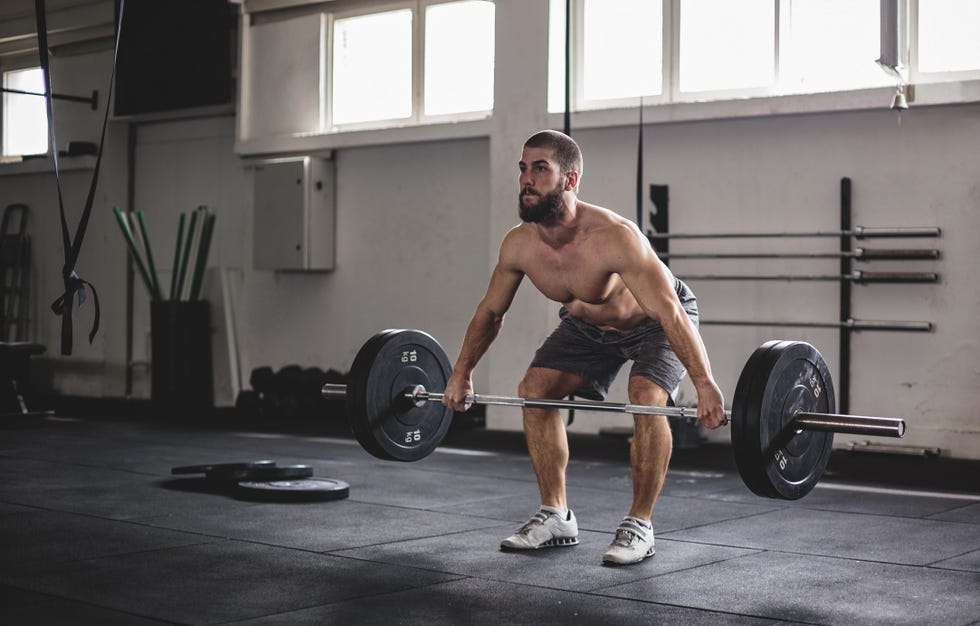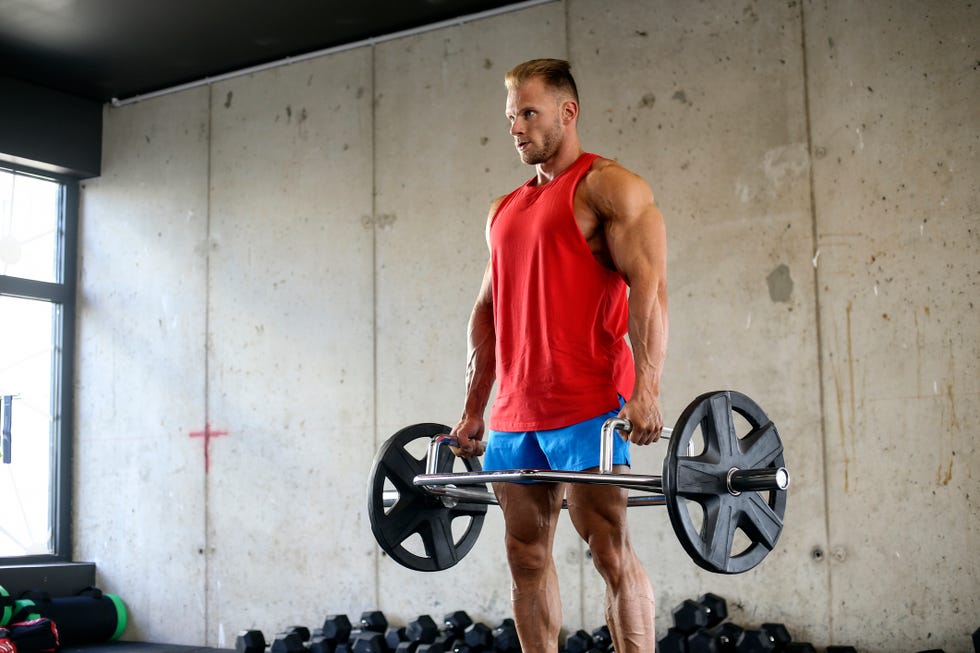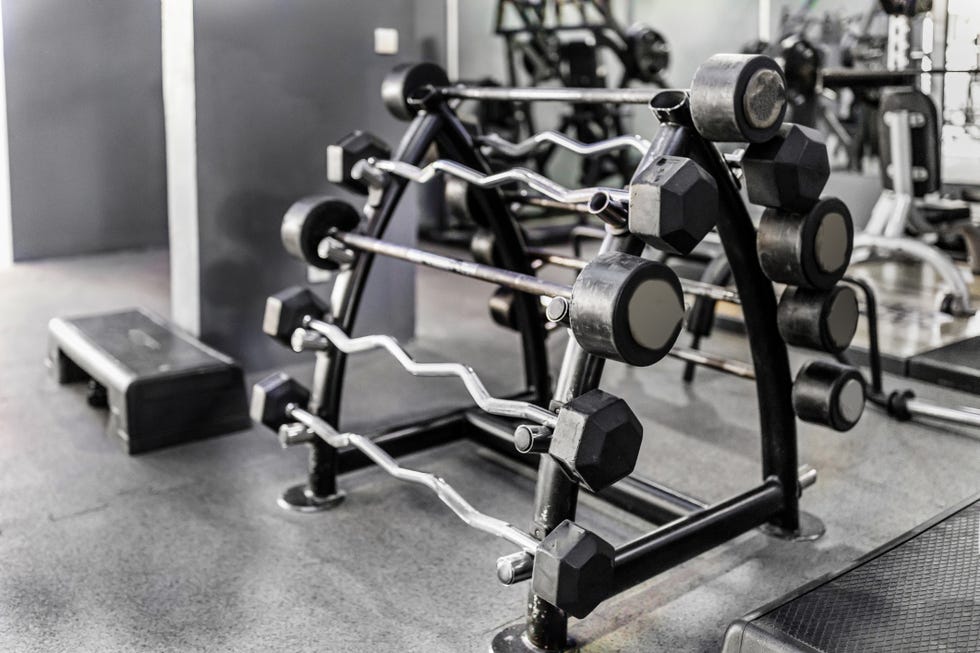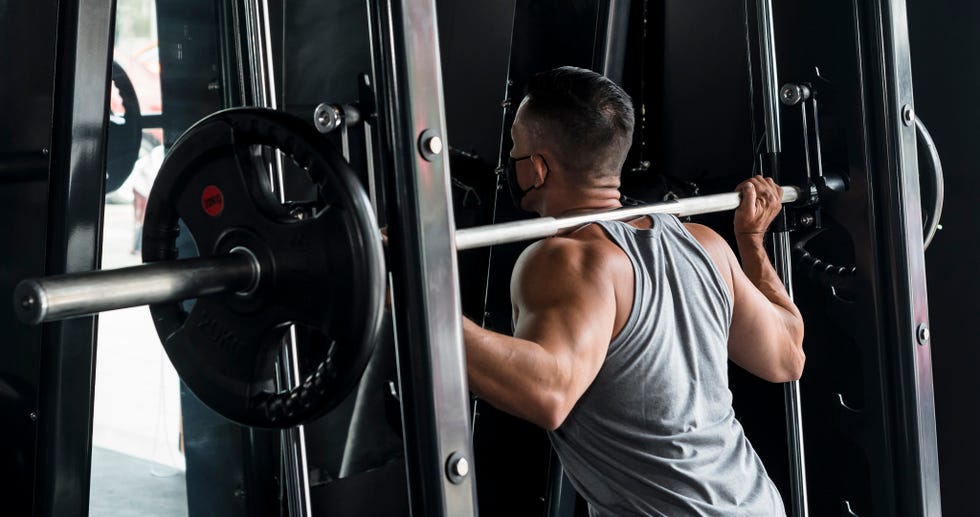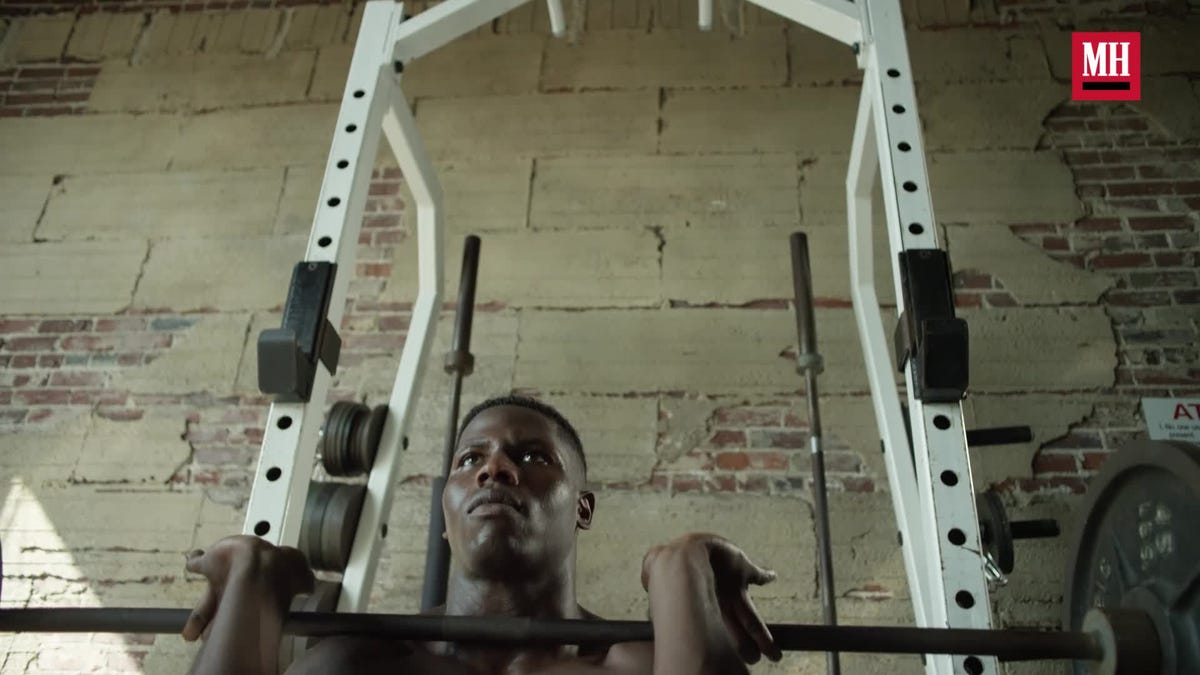EVERY AVID WEIGHTLIFTER understands the pains of constantly calculating weight totals. Just crushed an extra-heavy deadlift? Time to pull up the calculator app to see if adding all those plates broke your PR. This is good for more than just bragging rights, too; to build muscle or get stronger, you need to be progressively overloading your muscles by increasing challenge in your strength training. The simplest way to do that is to increase the amount of weight you’re working with—and if you’re doing heavy compound movements, you’re most likely doing that with a barbell.
Just make sure you don’t forget to add the weight of the bar itself into your calculations. Most equipment you’ll use is standardized, but while machines and free weights are usually clearly labeled, barbells are not.
That’s important, because there are actually several different kinds of barbells, and all “generally have the ability to add weights onto the end with the purpose of distributing a load,” explains Kelvin Gary, certified trainer and owner of Body Space Fitness gyms in New York City.
What Makes a Barbell?
While there’s a wide range of implements that lifters use for resistance, barbells have a few common characteristics. They’re generally made of steel or steel alloy, and are sometimes coated with other materials for enhanced durability.
“Most barbells also have crosshatch pattern groves called ‘knurling,’ which assist with grip,” Gary continues. The bars have sleeves, the long pieces at either end that allow you to load weight plates onto them. Usually these are between one and two inches in diameter, depending on the type of bar. Finally, you may also hear some referred to as a “women’s bar,” which is shorter, lighter, and has a smaller diameter for easier grip for those with smaller hands. However, Gary says he likes to refer to these more simply as a “small bar” versus the standard “big bar.”
Barbells will allow you to work with more load and perform movements in a different manner (typically with both hands) when compared to other implements like dumbbells, according to Gary. If you’re entirely new to barbell training, he recommends seeking out advice from a professional, whether that’s a trainer on the gym floor or setting up time for more formal one-on-one coaching.
Barbells are also a great way to add variety to your training. Think about the differences between a dumbbell goblet squat, a racked kettlebell squat, and a barbell front squat, Gary notes. Even if you use the same amount of load for each of these movements, all three would each feel different and offer slightly different benefits for your routine.
Here, Gary breaks down several common types of weight bars you’ll find in most fitness facilities including how to use them, the advantages of each, and yes—how much the bars typically weigh.
5 Types of Barbells and How Much They Weigh
From straight bars at different lengths to hex bars for deadlifts and EZ bars for curls, there’s so much more to the world of barbell exercises than you may have known. Take advantage of the variety.
Standard Barbell
Length: 6’5” to 7’2”
Weight: 33 to 45 pounds
The standard barbell is what you’ll likely gravitate toward for many of your lifts. That’s because it’s so versatile, easy to find in most gym settings, and makes it easier to start lifting heavier, according to Gary. Load both ends for balanced lifts or only one side for a landmine-style workout. Common exercises with the standard barbell include the bench press, deadlift, back squat, front squat, bent over rows—it’s a long list.
One thing to keep in mind when using the standard barbell is that it can be tricky for beginners, and nailing the form and technique is essential for limiting your injury risk. Remember, “it’s a larger tool that spans outside of your center of mass and base of support and calls for more ability to stabilize the load,” Gary says.
Olympic Barbell
Length: 7’2” (2.2 meters) for men, 6’5” (2 meters) for women
Weight: 44 pounds (20 kg) for men, 33 pounds (15 kg) for women
This style of bar is used in Olympic weightlifting and powerlifting competitions, so choosing the proper weight and length is pertinent, says Gary. But it’s just as important to utilize this barbell properly in the gym, too. It’s primarily used for power lifts, but can be used for all other movements, he says. You’ll most likely find Olympic bars in performance or sports-focused facilities, like powerlifting gyms and CrossFit boxes. The cap at the end of the sleeve, which often displays branding and weight information, is one way to identify these implements.
While all barbells have sleeves, Olympic bars have sleeves that spin more freely to assist in higher velocity movements such as cleans and snatches, he explains. This allows for the sleeves to rotate as you complete your exercise, often bringing the bar from a low position to chest or shoulder-height or extended above the head (as in the clean and jerk). This helps to prevent injuries such as to the wrist or elbow.
“One of the major differences between an Olympic bar and a standard bar is that Olympic bars have a larger rotating sleeve which allows you to control the bar better and have smoother transitions during complex movements,” says Gary. That’s why you may be able to get away with using either kind of bar for deadlifts, squats, and bench presses but you really shouldn’t use a standard bar for power lifts, he explains.
Trap Bar or Hex Bar
Length: 56” to 88”
Weight: 35 to 80 pounds
There are several types of these hexagonal-shaped bars, so the lengths and weights will vary. Some have a more square-shaped middle, which means the arm placement is closer to your body. Others have a more elongated opening for a wider grip option. Still others actually feature an open side to the hexagon so you can walk up to the bar rather than needing to step into it. There are also high-handle varieties, which give lifters a spot to grip that can shorten the distance between their hands and the bar, allowing them to work from slightly different positions.
“A major pro is that a trap bar allows you to stand in a position where you are more evenly aligned with the load, keeping the load closer to your center of mass,” says Gary. “This allows you to be more stable and potentially move a heavier load.”
Deadlifts are the go-to exercise for the hex bar, but you can also perform core stability work such as farmer’s carries, he says.
EZ Bar
Length: 3’
Weight: 10 to 35 pounds
This crooked barbell may look a little strange, but those strategically placed bends are there for a reason. “One of the major points about an EZ bar is that it allows you to vary your degrees of pronation and supination at the wrist, which not only can have some advantages in developing muscles in the forearm but also potentially provide some relief from gripping the bar if someone has wrist injuries or issues,” explains Gary.
That’s why you’ll often grab one of these bars when performing biceps curls or triceps extensions. Another optimal EZ bar exercise is the preacher curl on an arm bench, which allows for even more direct isolation of the biceps. Some EZ bars are fixed with weight plates already attached for a set weight and others have sleeves with the option to add load.
Fixed Barbell
Length: 3’
Weight: 10 to 150 pounds
A fixed barbell is similar in size to the EZ bar, but these small bars come fully loaded with a set weight. Think of it as a mix between a standard barbell and a dumbbell.
“They can be used for almost every exercise—lunges, squats, etc.—but are better for exercises requiring a more narrow grip like bicep curls and triceps extensions,” says Gary. Conversely, you shouldn’t use fixed barbells for movements that require a wider grip, such as deadlifts or Olympic-style lifts, he adds.
The good news is you can typically find fixed barbells in most commercial gyms, even those who may not otherwise have extensive equipment options or the space for full-sized barbells (think Planet Fitness). Plus, there’s basically no setup thanks to the pre-selected weights, but that does mean you’ll have to wait for your chosen weight to become available if it’s in use, says Gary.
Safety Squat Bar
Length: 7’3” to 7’9”
Weight: 35 to 80 pounds
Safety squat bars are designed for comfort and safety specific to back-racked exercises, like the barbell back squat. The bar offcenters the weight distribution, making the load more comfortable around the user’s neck. Specialized bars go along the sides of the head, so the user can gain control of the bar easier—especially useful if you struggle with shoulder mobility. Though often used for back squats, the bar can also be used for split squats, walking lunges, and more.
There are several different safety squat bar designs and manufacturers, so size and weight may vary. Some companies make the handlebars removable, which will affect the weight of the bar.
Smith Machine Bar
You might be curious about the weight of a Smith machine bar, given its fixed track system. Gary says most are equipped with the traditional 45 pound bar—and we found these machines range from 5 pounds up to 45, with most landing between 25 and 35 pounds. If you’re curious about the bar on the machine you’re using, check around the unit for a label sticker. That said, the comparisons to free weight bars stop there.
Smith machines, “remove the need for stabilization which gives a false sense of being able to move the load under control,” he says. “While the path of the bar during a squat or deadlift is vertical, it’s important that you’re able to effectively keep the bar on the path on your own.” So, if you are leveling up your strength training with barbell work, consider practicing on a standard bar with a lighter load to really nail the form.

Alyssa Sparacino is an ACE-certified personal trainer, former Shape editorial director, as well as an editor, and writer with a focus on fitness, health, and wellness. Her work has been published online and in print for brands including Shape, Health, Fortune, What to Expect, Men’s Journal, Ask Men, Travel & Leisure, Chewy, and more. When she’s not writing or lifting weights, you can find her hiking, exploring, and eating with her husband and rescue dog.
Cori Ritchey, C.S.C.S., is an Associate Health & Fitness Editor at Men’s Health, a certified strength and condition coach, and group fitness instructor. She reports on topics regarding health, nutrition, mental health, fitness, sex, and relationships. You can find more of her work in HealthCentral, Livestrong, Self, and others.
Read the full article here



